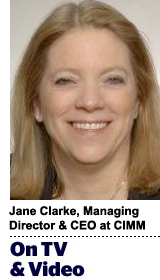
“On TV And Video” is a column exploring opportunities and challenges in advanced TV and video.
Today’s column is written by Jane Clarke, managing director and CEO at the Coalition for Innovative Media Measurement (CIMM).
Outcomes-based measurement is redefining advertising.
GSK recently launched a self-optimizing outcomes-based digital-out-of-home campaign informed by real-time data. This follows announcements earlier this year by A+E Networks, Hulu, NBCU and Horizon Media, which are each experimenting with outcomes-based models. And of course, just this week, LiveRamp announced that it is acquiring TV attribution provider Data Plus Math for $150 million.
With the ascendancy of ROI as the primary metric for assessing advertising, the pressure is mounting on brand leaders to show campaign effectiveness and ensure efforts are being optimized.
But the technology and methodologies for doing so are still very much in an early stage, and development is still underway. The future of TV attribution is taking shape now, guided by those who are early adopters.
But this is not a task that brands can be absent from in the hope that they can assign the heavy lifting of advancement to one’s agency.
If marketers expect to get the attribution technology they want and that best suits their needs, they need to speak up and get involved now.
Currently, there are widely varying approaches and methodologies being used. The opportunity exists for marketers to participate in the industry conversation by sharing their needs and helping to drive consensus and standardization within the industry in a manner that properly takes into account how they would like to utilize outcome measurement moving forward.
Some marketing leaders are now getting in the game and making their requirements known, but it’s early days, and the industry needs more input. For example, from informal conversations with advertisers, I hear that expectations of ad impressions measurement accompanied by a protected personal identifier are different than what the industry has been planning for. Advertisers have shared with me that they want to have more control over measurement and want access to a syndicated cross-media ad measurement service with cross-platform reach and frequency – so they can always measure campaigns on the fly.
Sometimes knowing marketer requirements can completely shift how we prioritize our efforts. For example, sidebar conversations with marketers have revealed that advertisers aren’t necessarily focused on content measurement. Instead, they are tired of tagging ads, a costly and painfully tedious process. I’m also hearing brand leaders lament about the lack of competitive visibility across campaigns. All of these requirements are very interesting, and I want to hear more.
As cross-platform measurement and attribution initiatives advance, the need for marketers to have their voices accounted for has never been greater.
To get the tools and measurement they want, brands need to get involved while there is an opportunity to contribute to the conversation and shape the future of outcomes-based measurement. They need to participate and share their point of view before the decisions are made for those that choose to be bystanders.
Follow CIMM (@CIMM_NEWS) and AdExchanger (@adexchanger) on Twitter.
This post was syndicated from Ad Exchanger.


More Stories
Marketing Morsels: Hidden Valley Ranch, La-Z-Boy, Topps & More
Flashback: Jane Pauley and Deborah Norville Revisit Today’s 1989 Succession Drama
Ally Financial Revives ‘Banksgiving’ With A TikTok Twist